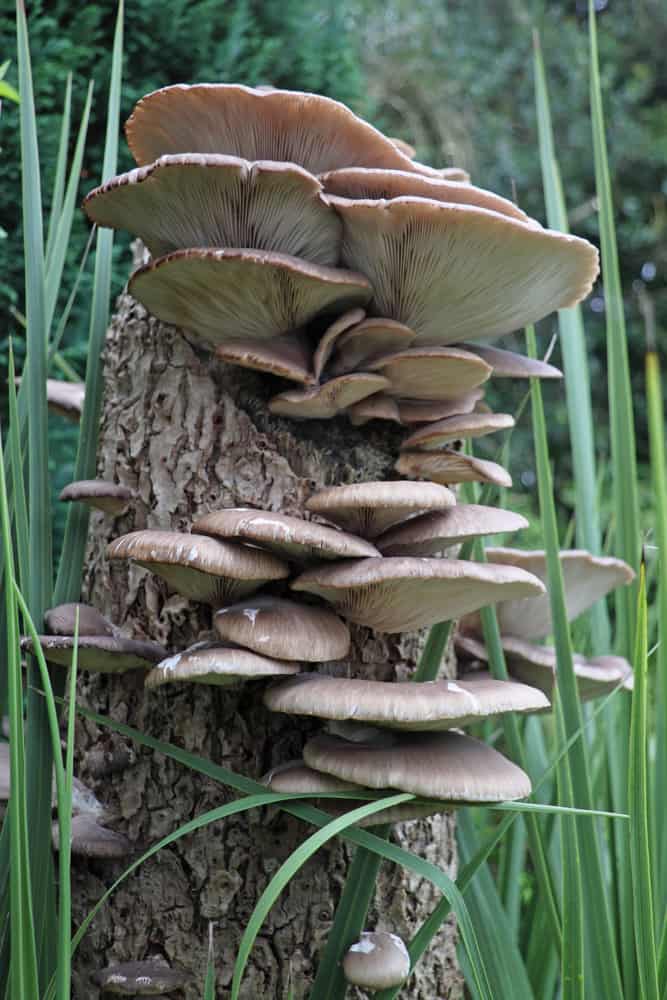
Do oyster mushrooms tickle your fancy? Perhaps you’re looking to find some wild-growing species in your area, or you’re a tad curious as to what they taste like before you commit to buying an entire pack from the supermarket.
In this comprehensive guide, we’ll delve into everything you need to know about wild oyster mushrooms, including how to find and cook them. Read on!
What Are Oyster Mushrooms?
Oyster mushrooms are a type of edible fungi and one of the most popularly consumed mushroom species across the globe. They derive their name from their oyster-shaped cap coupled with a short stalk or lack thereof.
Additionally, oyster mushrooms closely resemble raw oysters in color as they are grey-brown or light grey. Nonetheless, they come in a boatload of other colors, such as pink and yellow. Oyster mushrooms are the easiest mushroom species to grow, given their rapid growth, the vast assortment of substrates, and high tolerance to growing conditions.
What Do Oyster Mushrooms Taste Like?
When cooked, oyster mushrooms have a smooth texture and flavor that some describe as being similar to seafood. Other people also describe oyster mushrooms as having a mild anise flavor. Nevertheless, both flavors exude subtlety and go undetected once these mushrooms are added to a recipe. The flavor is mild with an earthy note.
When Are Oyster Mushrooms In Season?
In the wild, you’ll find oyster mushrooms during fall. The most opportune time is after the initial frost of the year or other major climate changes, such as the first sweltering hot weekend of spring.
Commercial oyster mushroom growers harvest these species year-round. Therefore, they are always available provided that your supermarket is stocking them. Most oyster mushrooms are grown in greenhouses or indoors under controlled conditions, which means there’s no bad or good season like other crops.
Where Can You Find Wild Oyster Mushrooms?
In nature, oyster mushrooms grow in clusters on fallen or rotting logs. Therefore, if you stumble upon one while mushroom hunting, you’re likely to find an entire bunch hurdled together. While cultivated oyster mushrooms usually grow individually, they still form large clusters.
Keep your eyes peeled for dead standing trees, logs, or fallen trees as potential habitats for oyster mushrooms. Remember to also check below trees that have toppled over as these species thrive more in the shade than exposed to direct sunlight. They usually grow on beech or oak trees in open, leafy, old forests.
Oyster mushrooms at an impressively fast rate, which means you’ll need to find them while they are still young, or else they might be quite leathery and unfit for consumption.
Types of Wild Oyster Mushrooms
We’ve rounded up a few wild oyster mushroom species.
Pearl Oyster
These are the most renowned type of wild oyster mushrooms and are prevalent in North America. A pearl oyster has a relatively woody and sweet flavor but is milder compared to the Shiitake species. A pearl oyster mushroom is also tender.
Blue Oyster
Contrary to the vibrant pink and golden oysters, Blue Oyster mushrooms are not vibrant blue as may assume. Instead, they are grey with a subtle blue hue. Furthermore, they have pale gills and dark caps. It’s this contrast that makes them aesthetically pleasing. Besides appearance, these mushrooms taste like pearl oysters and have a meaty texture, making them a great meat substitute.
Golden Oyster
As the name implies, Golden Oyster mushrooms are vibrant yellow with a more aromatic and complex flavor than generic pearl oysters.
Pink Oyster
Besides a ruffled cap, the vibrant color of Pink Oyster mushrooms fades when you cook them. These species are usually studier with a woody flavor that doesn’t appeal to some people.
Phoenix Oyster
Closely similar to Pearl Oyster mushrooms, the caps of the Phoenix Oysters are typically paler-looking and smaller. Furthermore, they usually have a longer stem than other species. Phoenix Oysters thrive in a warmer climate which is why you’re likely to see them growing during summer rather than fall or winter.
King Oyster
As the biggest species of Oyster mushrooms, King Oyster differs from other Pleurotus mushrooms in appearance. They grow individually rather than in clusters and have thick, white, meaty stems coupled with tan-colored caps. King Oyster is native to Asia, the Mediterranean, Middle East, and Northern Africa.
How to Identify Wild Oyster Mushrooms

Other wild mushroom species may closely resemble wild oyster mushrooms for a novice forager, so you need to tread carefully if you don’t have much experience in identification. You need to ensure you’ve accurately identified your mushrooms before consuming them. When in doubt, steer clear of them. With that being said, here are a few ways to identify wild oyster mushrooms.
1. Cap
Keep your eyes peeled for an oyster-shaped or fan-shaped cap. Oyster mushrooms usually have a width of 2 to 10 inches (5cm to 25cm) with a smooth texture (no warts or scales). The flesh of an oyster mushroom is white, sturdy, and typically brown-white at the top. Furthermore, it tends to grow in a shelf-like formation with overlapping clusters.
2. Gills
Oyster mushrooms have gills that are connected to the stem and run down. The gills are also usually white.
3. Stem
An oyster mushroom often lacks a stem. However, if there’s one, it’s short, stubby, and grows off-center. These species grow on a log and have a well-developed stem compared to oyster mushrooms growing on the side. There’s no sack around the stem base or a rim encircling it.
4. Spore Print
Check the newly found wild oyster mushrooms for spore sprints on a dark backdrop. They should be lilac-grey or white.
5. Environment
Oyster mushrooms thrive on dead organic material, which means they are Saprotrophic. Therefore, you should be a skeptic if you find them growing on healthy trees. If they grow on dying or unhealthy trees and dead logs, then that’s a great sign. Oyster mushrooms thrive on deciduous hardwood tree such as beech or aspen. However, they also grow on coniferous trees.
6. Smell
Some people claim that oyster mushrooms smell like anise or black licorice.
How to Clean Wild Oyster Mushrooms
Oyster mushrooms don’t call for much when it comes to cleaning. Given that they grow on wood, they’re usually in contact with dirt. Wiping them off with a paper towel will get the job done.
However, if you want to be thorough, you can rinse them with running cold water to ensure you get all the grit and dirt out. However, don’t do so for more than 3 minutes as that will cause them to lose their potency by washing away some of the nutrients.
How to Cook Wild Oyster Mushrooms
Oyster mushrooms are perfectly sautéed and consumed as a side dish or added to stir-fried recipes. When cooking them, here are a few pointers to keep in mind.
- Ensure you leave additional space for moisture to cook
- Avoid overcrowding them, or they’ll become soggy and steam rather than properly sauté
- Oyster mushrooms are a great addition to stews and soups. Furthermore, you can feed them to babies when they are at least six months old and ready to try solid foods
- You can batter oyster mushrooms in flour and fry them as a delicious appetizer
- They are perfect pizza toppings
- Oyster mushrooms are a great addition to pasta sauces and other dishes that you’d add Portobello or button mushrooms
Consuming raw oyster mushrooms isn’t recommended as they have an unpleasant metallic flavor. Furthermore, they develop a pleasant velvety texture once cooked, which is a better feeling in the mouth.
Nutrition Information
The nutrition levels of wild oyster mushrooms are closely similar to other species such as Portobello. One cup of oyster mushrooms has about 5g protein, 65 calories, 10g carbohydrates, and less than 1g fat. These are also rich in minerals and vitamins ranging from folate and potassium to magnesium.
Health Benefits of Wild Oyster Mushrooms
Now that you know how to identify, clean, and cook these species, let’s discuss the health benefits of wild oyster mushrooms.
Rich In Antioxidants
Besides vitamins and minerals, oyster mushrooms contain powerful antioxidants that are useful for the body.
Cholesterol Reduction
They significantly reduce the cholesterol level in the body and slow down the spread of cancer. That’s because oyster mushrooms contain a compound known as Statins which is why if you have high levels of cholesterol, your doctor might have put you on a Statin drug, for instance, Lipitor. Statins work to diminish the bad cholesterol (LDL) in your body by signaling your liver to excrete it from your system.
Polysaccharides
These compounds found in wild oyster mushrooms have possible anti-tumor effects. Furthermore, they contain beta-glucans that boost the immune system and help fight cancer.
Conclusion
Now that you know how to identify, find, and cook wild oyster mushrooms, the ball is in your court. You can revel in the process of foraging them, whipping up a wealth of mouth-watering dishes, and reaping the nutritional benefits. During your hunting escapades, when in doubt, always consult a professional. After all, the last thing you need is accidentally consuming a poisonous oyster mushroom lookalike that can be fatal or trigger severe allergies.




